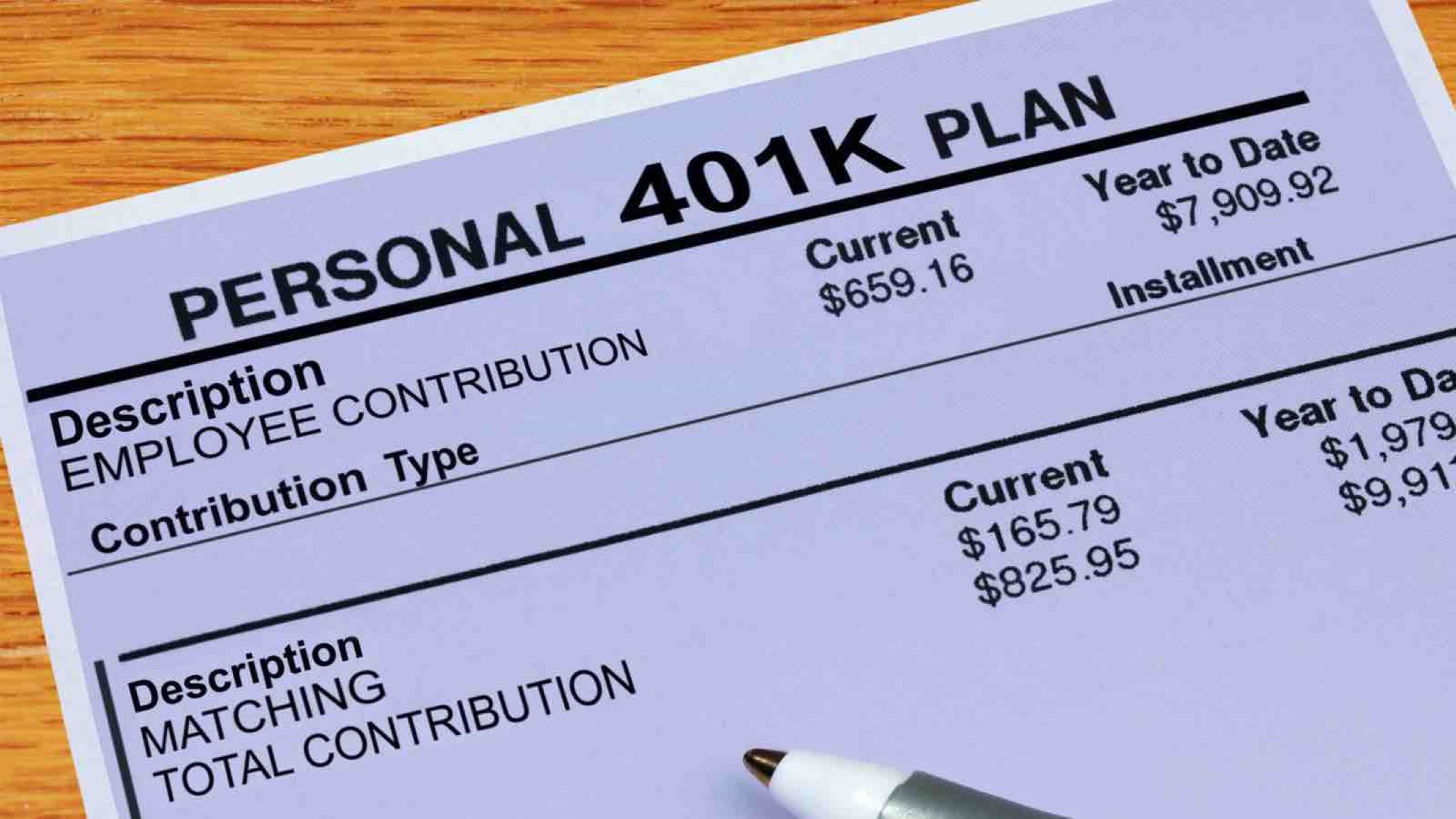

Finance
How Much 401K Can I Contribute
Modified: February 21, 2024
Discover how much you can contribute to your 401K and maximize your retirement savings. Get expert advice on finance and plan for a secure future.
(Many of the links in this article redirect to a specific reviewed product. Your purchase of these products through affiliate links helps to generate commission for LiveWell, at no extra cost. Learn more)
Table of Contents
- Introduction
- Understanding 401K Contribution Limits
- Employer Matching Contributions
- Traditional vs. Roth 401K Contributions
- Contribution Limits for 2021
- Catch-Up Contributions for Individuals Age 50 and Older
- Methods to Maximize 401K Contributions
- Potential Penalties for Exceeding Contribution Limits
- Conclusion
Introduction
Welcome to the world of 401K contributions, where you have the power to shape your financial future. Understanding how much you can contribute to your 401K is essential for maximizing your retirement savings and taking advantage of potential employer matching contributions.
A 401K is a popular retirement savings plan offered by many companies to their employees. It allows individuals to contribute a portion of their pre-tax income, which grows tax-deferred until withdrawal during retirement. Contributing to a 401K not only helps you build a nest egg for the future, but it also offers potential tax advantages and employer matching opportunities.
However, it’s important to be aware of the contribution limits imposed by the Internal Revenue Service (IRS) to ensure compliance and avoid potential penalties. The contribution limits can vary from year to year and depend on your age and the type of 401K plan you have.
In this article, we will dive into the details of 401K contribution limits, employer matching contributions, traditional versus Roth 401K contributions, and strategies to maximize your contributions. Additionally, we will discuss the potential penalties you may face if you exceed the contribution limits.
So, whether you’re a seasoned professional or just starting out in your career, understanding how much you can contribute to your 401K is vital to making the most of this powerful retirement savings tool. Let’s explore the world of 401K contributions together and pave the way for a financially secure future.
Understanding 401K Contribution Limits
401K contribution limits refer to the maximum amount of money you can contribute to your 401K plan in a given year. These limits are set by the IRS and are designed to prevent individuals from excessively sheltering income from taxes.
Currently, the annual contribution limit for 401K plans is $19,500 for individuals under the age of 50. This means that you can contribute up to $19,500 of your pre-tax income to your 401K account in a calendar year. However, if you’re 50 years of age or older, you have the option to make additional catch-up contributions, allowing you to contribute even more.
It’s important to note that the contribution limit applies to each individual’s total contributions across all of their 401K plans. If you have multiple 401K plans with different employers, you need to ensure that your combined contributions do not exceed the annual limit. Additionally, employer matching contributions do not count towards your personal contribution limit.
It’s equally important to understand that 401K contributions are subject to a maximum limit for highly compensated individuals (HCIs). To maintain the fairness of the plan, the IRS imposes these limits to prevent HCIs from disproportionately benefiting from the tax advantages of 401K plans. The specific limit for HCIs may vary each year and is calculated based on the average deferral percentage of non-highly compensated employees.
While it’s crucial to strive to contribute the maximum allowable amount to your 401K, keep in mind that you must also consider your overall financial situation. It’s important to strike a balance between saving for retirement and meeting your current financial needs. If contributing the maximum amount to your 401K poses a financial burden, consider contributing an amount that aligns with your goals and financial capabilities.
Now that we have a good understanding of the contribution limits, let’s explore the concept of employer matching contributions and how they can further boost your retirement savings.
Employer Matching Contributions
One of the primary benefits of participating in a 401K plan is the potential for employer matching contributions. These contributions are essentially free money from your employer that can significantly boost your retirement savings.
Employer matching contributions are a percentage of your own contributions that your employer agrees to contribute to your 401K plan on your behalf. The specific matching formula and percentage can vary from company to company. For example, a common matching formula is a 50% match on your contributions up to a certain percentage of your salary.
Let’s say your employer offers a 50% match on your contributions up to 6% of your salary. If your annual salary is $50,000, you would need to contribute at least $3,000 (6% of $50,000) to receive the full employer match. In this case, your employer would contribute an additional $1,500 (50% of $3,000) to your 401K account. This translates to a total contribution of $4,500, with $3,000 coming from your salary and $1,500 provided by your employer.
It’s important to take advantage of employer matching contributions as they can significantly accelerate the growth of your retirement savings. When you contribute enough to receive the full employer match, you’re essentially doubling your contribution, increasing the overall value of your retirement account.
However, it’s crucial to understand the specific matching rules and limits set by your employer. Some companies may require a certain period of service before you become eligible for matching contributions, while others may have different matching percentages or contribution limits. Be sure to review your company’s 401K plan documents or consult with your HR department to fully understand your employer’s matching contribution policy.
Now that we’ve explored the benefits of employer matching contributions, let’s dive into the differences between traditional and Roth 401K contributions and how they can impact your retirement savings strategy.
Traditional vs. Roth 401K Contributions
When it comes to contributing to a 401K, you have the option to choose between traditional and Roth contributions. Understanding the differences between these two types is crucial in determining which one aligns better with your retirement goals and tax strategy.
Traditional 401K contributions are made with pre-tax dollars. This means that the money you contribute to your 401K is deducted from your taxable income for the year. Consequently, the contributions grow tax-deferred, and you’ll only pay taxes on the withdrawals made during retirement. Traditional 401K contributions can be advantageous if you anticipate being in a lower tax bracket during retirement, as it allows you to postpone paying taxes on your contributions until your income is potentially lower.
Roth 401K contributions, on the other hand, are made with after-tax dollars. This means that the money you contribute to your Roth 401K has already been taxed, and withdrawals made during retirement are tax-free, provided you meet certain criteria. Roth contributions can be advantageous if you expect to be in a higher tax bracket during retirement, as you’re essentially locking in your tax rate now and allowing your contributions to grow tax-free.
Choosing between traditional and Roth 401K contributions requires careful consideration of your current and future financial situation. Factors such as your income level, expected tax bracket in retirement, and personal preferences all play a role in deciding which option is best for you.
It’s worth noting that some employers offer a Roth 401K option, while others only offer traditional 401K plans. If your employer provides the Roth option, you have the flexibility to split your contributions between traditional and Roth accounts. This can be a strategic move to diversify your retirement savings and have the flexibility to withdraw from different types of accounts during retirement, depending on your tax situation at that time.
Now that we’ve explored the differences between traditional and Roth 401K contributions, let’s take a closer look at the specific contribution limits for 2021.
Contribution Limits for 2021
Knowing the contribution limits for your 401K plan is crucial for maximizing your retirement savings. For the year 2021, the IRS has set the following contribution limits for 401K plans:
- The annual contribution limit for individuals under the age of 50 is $19,500. This means that if you are below the age of 50, you can contribute up to $19,500 of your pre-tax income to your 401K plan during the year.
- If you are 50 years of age or older, you have the option to make additional catch-up contributions. The catch-up contribution limit for individuals aged 50 and above is $6,500, making the total allowable contribution limit $26,000 for this age group.
It’s important to note that these contribution limits apply to your personal contributions and do not include any employer matching contributions. Employer matching contributions are typically separate from these limits and can vary depending on your employer’s matching policy.
Furthermore, it’s important to keep in mind that these limits are set by the IRS and may be subject to change in future years. It’s advisable to stay updated with any changes in the contribution limits to ensure compliance with the regulations and take full advantage of the available opportunities to save for retirement.
Maximizing your contributions to your 401K plan can have a significant impact on your retirement savings. By contributing the maximum amount allowed, you can harness the power of compounding interest and potentially grow your retirement nest egg more effectively over time.
Now that we’ve covered the contribution limits for 2021, let’s explore catch-up contributions and how they can benefit individuals aged 50 and older.
Catch-Up Contributions for Individuals Age 50 and Older
If you are age 50 or older, the IRS allows you to make additional contributions to your 401K plan above and beyond the regular annual limits. These additional contributions are known as catch-up contributions and are designed to help individuals who are closer to retirement age boost their retirement savings.
For the year 2021, the catch-up contribution limit for individuals aged 50 and above is $6,500. This means that if you are 50 or older, you can contribute an extra $6,500 on top of the regular contribution limit. This brings your total allowable contribution limit to $26,000.
Catch-up contributions can provide a valuable opportunity for individuals who may have fallen behind on their retirement savings or who want to accelerate their savings in the years leading up to retirement. By taking advantage of catch-up contributions, you can potentially make up for lost time and build a more secure financial future.
It’s important to note that catch-up contributions are optional and not everyone may need or be able to contribute the maximum catch-up amount. Your ability to make catch-up contributions will depend on your financial situation and ability to allocate additional funds towards retirement savings.
Additionally, it’s worth mentioning that catch-up contributions can be made in both traditional and Roth 401K plans. This means that you have the flexibility to make catch-up contributions according to your preferred tax strategy and retirement goals.
As with regular contributions, catch-up contributions are subject to the same rules and regulations regarding distribution and tax implications. Be sure to consult with a financial advisor or tax professional to understand the specific guidelines and implications of catch-up contributions based on your individual circumstances.
Now that we have covered catch-up contributions for individuals aged 50 and older, let’s explore some methods to maximize your 401K contributions and make the most of your retirement savings potential.
Methods to Maximize 401K Contributions
Maximizing your 401K contributions is a key strategy for building a robust retirement savings nest egg. Here are some methods to help you make the most of your 401K:
- Contribute up to the maximum limit: One of the most effective ways to maximize your 401K contributions is to contribute up to the annual maximum limit set by the IRS. For 2021, this limit is $19,500 for individuals under the age of 50. By contributing the maximum amount, you can take full advantage of the tax benefits and potential employer matching contributions.
- Start early and prioritize consistency: The power of compounding works best over time. Starting to contribute to your 401K as early as possible allows your contributions to grow and compound over a longer duration. Make it a priority to consistently contribute to your account, even if it’s a small amount initially. Consistency is key to maximizing your long-term savings.
- Take advantage of employer matching: Employer matching contributions can be a valuable benefit that boosts your retirement savings. Find out if your employer offers matching contributions and strive to contribute at least enough to receive the full employer match. This essentially provides you with free money towards your retirement savings.
- Consider increasing contributions with salary raises: Whenever you receive a salary raise or bonus, consider allocating a portion of it towards your 401K contributions. This allows you to increase your savings without impacting your current lifestyle significantly. By “paying yourself first” and increasing your contributions with each raise, you can accelerate the growth of your retirement savings.
- Take advantage of catch-up contributions: If you’re age 50 or older, make use of the catch-up contributions allowed by the IRS. Contributing the additional $6,500 can give your retirement savings a significant boost, especially if you’re running behind on your savings goals.
- Automate your contributions: Setting up automatic contributions from your paycheck can ensure consistent and regular contributions to your 401K. This eliminates the temptation to spend the money elsewhere and makes saving for retirement effortless.
- Review and adjust your investment options: Regularly review your investment options within your 401K plan and ensure they align with your risk tolerance and long-term goals. Make necessary adjustments to maximize your returns and optimize your portfolio.
- Explore other retirement savings options: If you’ve maxed out your 401K contributions and still have additional funds to save for retirement, consider exploring other tax-advantaged retirement savings options like IRAs or HSA accounts. These accounts offer additional opportunities to grow your retirement savings while providing potential tax advantages.
By implementing these methods and being proactive in your retirement savings strategy, you can maximize your 401K contributions and set yourself up for a financially secure future.
Now, let’s explore the potential penalties you may face if you exceed the contribution limits and how to avoid them.
Potential Penalties for Exceeding Contribution Limits
While it’s important to maximize your 401K contributions, it’s equally important to stay within the contribution limits set by the IRS. Exceeding these limits can result in potential penalties and tax implications. Here are the potential penalties for exceeding 401K contribution limits:
1. Excess contribution withdrawal: If you contribute more than the allowable annual limit to your 401K, you must withdraw the excess amount before the tax filing deadline for that year, including extensions. Failure to do so may result in penalties and additional taxes on the excess amount.
2. Additional taxes and penalties: If you fail to withdraw the excess contributions within the required timeframe, the IRS may impose a 6% excise tax penalty on the excess amount. This penalty is applied each year until the excess contributions are corrected.
3. Taxation on excess contributions: Excess contributions that are not withdrawn in time may be subject to taxation. These contributions are considered taxable income for the year in which they were made. This results in potential double taxation, as the excess amount was already contributed with pre-tax dollars.
4. Loss of tax benefits: Excess contributions that remain in the 401K account may lose their tax-deferred status. This means that the excess amount, along with the earnings on that amount, may become subject to immediate taxation.
5. Corrective distributions: If you exceed the contribution limits and fail to withdraw the excess amount in time, your plan administrator may be required to distribute the excess contributions and any associated earnings to you. These distributions are taxable and can disrupt your long-term retirement savings strategy.
It’s crucial to monitor your 401K contributions throughout the year to ensure you don’t exceed the contribution limits. Communicate with your plan administrator or HR department to stay informed about your contributions and any adjustments that may be necessary to stay within the limits.
If you realize that you’ve exceeded the contribution limits, take immediate action to correct the situation. Work with your plan administrator to withdraw the excess contributions and follow the necessary steps to avoid penalties and mitigate any potential tax implications.
By staying vigilant and adhering to the contribution limits, you can optimize your retirement savings strategy and avoid unnecessary penalties that could undermine your long-term financial goals.
Now, let’s wrap up our discussion on 401K contributions.
Conclusion
Understanding the intricacies of 401K contribution limits is crucial for maximizing your retirement savings potential. By knowing how much you can contribute to your 401K plan, you can take full advantage of the tax benefits, employer matching contributions, and the power of compounding interest.
Throughout this article, we’ve explored various aspects of 401K contributions, including the contribution limits, employer matching contributions, traditional versus Roth contributions, catch-up contributions for individuals aged 50 and older, methods to maximize contributions, and the potential penalties for exceeding contribution limits.
Contributing up to the maximum allowable amount, starting early, prioritizing consistency, and taking advantage of employer matching contributions are effective strategies for maximizing your 401K contributions. Additionally, exploring catch-up contributions, automating your contributions, reviewing your investment options, and considering other retirement savings options can further enhance your retirement savings journey.
It’s vital to stay informed about the contribution limits set by the IRS and regularly review your contributions to ensure compliance. Exceeding the contribution limits can lead to potential penalties, additional taxes, and even loss of tax benefits. However, by proactively monitoring your contributions and taking corrective action when necessary, you can avoid these pitfalls and stay on track towards your retirement goals.
Remember, your 401K is a powerful tool for building a secure financial future. By contributing diligently, making informed decisions, and being proactive with your retirement savings strategy, you can create a solid foundation for a comfortable and financially independent retirement.
So, take charge of your 401K contributions, explore the available options, and make informed decisions that align with your financial goals. Start investing in your future today, and enjoy the peace of mind that comes with knowing you’re setting yourself up for a prosperous retirement.














